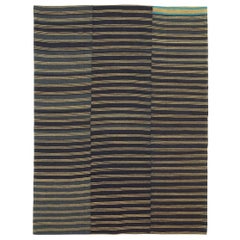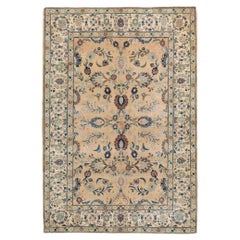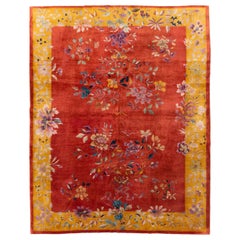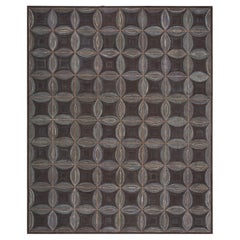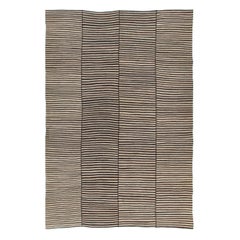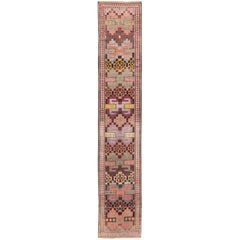Manhattan - More Carpets
to
764
Width
to
Length
to
3,927
758
61
445
200
113
78
64
64
33
20
20
18
12
10
2
2
2
39
471
3,417
819
1,351
1,242
150
56
44
107
62
29
60
42
32
8
5
4,707
4,507
312
128
35
4,746
24,784
3,138
4,746
4,679
4,741
4,164
3,422
2,058
1,364
1,234
117
63
39
8
8
Item Ships From: Manhattan
Mid-20th Century Turkish Flat-Weave Kilim Accent Rug
Located in New York, NY
A vintage Turkish flat-weave Kilim accent rug handmade during the mid-20th century.
Measures: 6' 2" x 8' 3".
Category
Mid-20th Century Turkish Modern Manhattan - More Carpets
Materials
Wool
Mid-20th Century Handmade Persian Tabriz Accent Rug
Located in New York, NY
A vintage Persian Tabriz accent rug handmade during the Mid-20th Century.
Measures: 4' 6" x 6' 7"
Category
Mid-20th Century Persian Tabriz Manhattan - More Carpets
Materials
Wool
Galerie Shabab Collection Mid-20th Century Chinese Art Deco Room Size Carpet
Located in New York, NY
A vintage Chinese Art Deco room size carpet handmade during the Mid-20th Century.
Measures: 8' 11" x 11' 7".
Category
Mid-20th Century Chinese Art Deco Manhattan - More Carpets
Materials
Wool
Contemporary American Hooked Rug 9' 0" x 12' 0" (274 x 366 cm)
Located in New York, NY
American Hook rug 9'0" x 12'0". Wool. Hand-Woven.
Category
21st Century and Contemporary Chinese Manhattan - More Carpets
Materials
Wool
Antique Persian Mazandaran Handwoven Flatweave Stripe Rug in Black and Beige
Located in New York, NY
Made of finest Persian hand-spun wool, our Mazandaran collection highlights the Minimalist sophistication that existed long before the modern era. The collection was inspired by the ...
Category
1910s Persian Kilim Vintage Manhattan - More Carpets
Materials
Wool
Mid-20th Century Handmade Turkish Anatolian Long Runner
Located in New York, NY
A vintage Turkish Anatolian long runner handmade during the mid-20th century.
Measures: 2' 11" x 15' 5".
Category
Mid-20th Century Turkish Tribal Manhattan - More Carpets
Materials
Wool
Mid-20th Century Handmade Persian Art Deco Square Paisley Scatter Rug
Located in New York, NY
A vintage Persian Mashad Art Deco square scatter rug handmade during the mid-20th century with 2 paisley (boteh) motifs on inverse corners over an ivory Minimalist and borderless gro...
Category
Mid-20th Century Persian Art Deco Manhattan - More Carpets
Materials
Wool
$3,700 Sale Price
20% Off
Tribal Mid-20th Century Handmade American Flatweave Navajo Throw Rug
Located in New York, NY
A vintage American flatweave throw rug handmade by the Navajo tribe during the mid-20th century.
Measures: 2' 7" x 4' 4".
Category
Mid-20th Century American Tribal Manhattan - More Carpets
Materials
Wool
Vintage Mid-20th Century Turkish Sivas Deco Rug
Located in New York, NY
A vintage Turkish Sivas deco carpet from the mid-20th century.
Measures: 6' 5" x 9' 7".
Category
Mid-20th Century Turkish Art Deco Manhattan - More Carpets
Materials
Wool
$7,600 Sale Price
20% Off
Tribal Mid-20th Century Handmade Persian Pictorial Gabbeh Accent Rug
Located in New York, NY
A vintage Persian Gabbeh tribal accent rug handmade during the mid-20th century with a pictorial design of a lion.
Measures: 4' 0" x 7' 0".
Category
Mid-20th Century Persian Tribal Manhattan - More Carpets
Materials
Wool
Early 20th Century Handmade Persian Mahal Room Size Carpet
Located in New York, NY
An antique Persian Mahal room size carpet handmade during the early 20th century.
Measures: 7' 9" x 11' 7".
Category
Early 20th Century Persian Rustic Manhattan - More Carpets
Materials
Wool
Modern Turkish Flat-Weave Room Size Rug
Located in New York, NY
A modern Turkish flat-woven Kilim room size rug from the 21st century.
Category
21st Century and Contemporary Turkish Kilim Manhattan - More Carpets
Materials
Wool
Vintage Belgium Jan De Cock Art Rug. Size: 6 ft 6 in x 8 ft
Located in New York, NY
Breathtaking Vintage Belgium Jan De Cock Art Rug, Country of Origin: Belgium, Circa Date: Early 20th Century - Size: 6 ft 6 in x 8 ft (1.98 m x 2.44 m).
Category
Early 20th Century Belgian Bauhaus Manhattan - More Carpets
Materials
Wool
Rustic Southwestern Style North American Navajo Tribal Throw Rug, circa 1920
Located in New York, NY
An antique North American Navajo tribal flat-weave throw rug in the rustic southwestern style handmade during the early 20th century.
Measures: 2' 11" x 4' 3".
Category
Early 20th Century American Rustic Manhattan - More Carpets
Materials
Wool
Early 20th Century Handmade Persian Tabriz Large Room Size Carpet
Located in New York, NY
An antique Persian Tabriz large room size carpet handmade during the early 20th century with a tone on tone washed out appeal.
Measures: 11' 2" x 14' 11".
Category
Early 20th Century Persian Edwardian Manhattan - More Carpets
Materials
Wool
Schumacher Abstract Ikat 10' x 14' I/O Rug In Stone
By Schumacher
Located in New York, NY
This rug will ship in December. Made of super-durable, eco-friendly PET , Abstract Ikat is a rhythmic broken stripe with a soft texture and wonderful dimension. Inspired by our popul...
Category
21st Century and Contemporary American Modern Manhattan - More Carpets
Materials
Polyester
$3,155 / item
Zabihi Collection Vintage Tribal Square Size Rug
Located in New York, NY
a mid-20th-century Turkish Kars Square Rug
Details
rug no. j4332
size 6' 7" x 7' (201 x 213 cm)
Category
Mid-20th Century Turkish Islamic Manhattan - More Carpets
Materials
Wool
Antique Sultanabad Persian Rug. Size: 11' 10" x 19'
Located in New York, NY
Antique Sultanabad carpet, country of origin: Persia, circa 1900. Size: 11 ft 10 in x 19 ft (3.61 m x 5.79 m).
Category
Early 20th Century Persian Sultanabad Manhattan - More Carpets
Materials
Wool
Late 19th Century Tunisian Gafsa Carpet ( 5'9" x 7'5" - 175 x 226 )
Located in New York, NY
Late 19th Century Tunisian Gafsa Carpet ( 5'9" x 7'5" - 175 x 226 )
Category
1890s Tunisian Antique Manhattan - More Carpets
Materials
Wool
Edouard Benedictus French Art Deco Rug. 10 ft 10 in x 13 ft 2 in
Located in New York, NY
Beautiful Edouard Benedictus French Art Deco Rug, Country of Origin / Rug Type: French Art Deco, Circa Date: 1930’s – Size: 10 ft 10 in x 13 ft 2 in (3.3 m x 4.01 m)
Category
Early 20th Century French Art Deco Manhattan - More Carpets
Materials
Wool
Midcentury Swedish Handmade Green Pictorial Rug With Elephants and Teddy Bears
Located in New York, NY
A vintage Swedish Pictorial rug handmade during the mid-20th century with saturated red elephants on the corners of the green field. An allover floral medallion with four teddy bears...
Category
Mid-20th Century Swedish Modern Manhattan - More Carpets
Materials
Wool
Vintage Persian Pictorial Hamadan Rug
Located in New York, NY
A vintage Persian Hamadan carpet from the mid-20th century with a pictorial folk design of Safavid ruler, Shah Abbas.
Measures: 1' 6" x 2' 4".
Category
Mid-20th Century Persian Folk Art Manhattan - More Carpets
Materials
Wool
$1,280 Sale Price
20% Off
Early 20th Century Handmade Persian Tabriz Large Room Size Carpet
Located in New York, NY
An antique Persian Tabriz large room size carpet handmade during the early 20th century.
Measures: 11' 2" x 16' 8".
Category
Early 20th Century Persian Victorian Manhattan - More Carpets
Materials
Wool
Antique Aubusson-Beauvais Rug 5'1'' x 6'2''
Located in New York, NY
Aubusson is located to the southwest of Paris and has been weaving floor carpets and wall han gings, almost all in the tapestry, pileless technique, since the mioddle of the 18th cen...
Category
1890s French Antique Manhattan - More Carpets
Materials
Wool, Silk
Beautiful Large Size Vintage Spanish Rug 13'10" x 17'6"
Located in New York, NY
Beautiful Large Size Vintage Spanish Rug, Country of Origin: Spain, Circa Date: Mid 20th Century - Size: 13 ft 10 in x 17 ft 6 in (4.22 m x 5.33 m).
Category
Mid-20th Century Spanish Spanish Colonial Manhattan - More Carpets
Materials
Wool
Antique Persian Sultanabad Rug. 16 ft 10 in x 21 ft 10 in
Located in New York, NY
Rustic Oversized Decorative Antique Luxurious Persian Sultanabad Rug, Country of Origin: Persian Rugs. Circa date: 1880. Size: 16 ft 10 in x 21 ft 10 in (5.13 m x 6.65 m)
Category
19th Century Persian Sultanabad Antique Manhattan - More Carpets
Materials
Wool
Antique French Aubusson Rug. 6 ft 4 in x 8 ft 3 in
Located in New York, NY
Antique French Aubusson Rug, country of origin / rug type: French rug, Circa date: 18th Century. Size: 6 ft 4 in x 8 ft 3 in (1.93 m x 2.51 m)
Category
18th Century French Aubusson Antique Manhattan - More Carpets
Materials
Wool
Geometric Antique Persian Heriz Rug. Size: 9 ft 2 in x 11 ft 8 in
Located in New York, NY
Geometric Antique Persian Heriz Rug, Country of Origin / rug type: Persian Rugs, Circa date: 1920. Size: 9 ft 2 in x 11 ft 8 in (2....
Category
20th Century Persian Heriz Serapi Manhattan - More Carpets
Materials
Wool
Early 20th Century Handmade Persian Mahal Room Size Carpet
Located in New York, NY
An antique Persian Mahal room size carpet handmade during the early 20th century.
Measures: 8' 0" x 11' 5".
Category
Early 20th Century Persian Rustic Manhattan - More Carpets
Materials
Wool
Antique Persian Tabriz Oriental Carpet in Room Size with Repeating Design
Located in New York, NY
Antique Persian Tabriz Oriental Carpet, circa 1920, Room Sized
An antique Persian Tabriz oriental carpet, circa 1920. Size: 8'3" x 8'0". This large sized antique decorative rug was...
Category
1920s Persian Vintage Manhattan - More Carpets
Materials
Wool
$11,516 Sale Price
20% Off
Early 20th Century Handmade Persian Mahal Room Size Carpet
Located in New York, NY
An antique Persian Mahal room size carpet handmade during the early 20th century.
Measures: 8' 9" x 12' 6".
Category
Early 20th Century Persian Rustic Manhattan - More Carpets
Materials
Wool
Brown Modern Turkish Minimalist Kilim
Located in New York, NY
One of a kind Turkish Kilim in brown
7' x 10'4''
Category
1990s Turkish Modern Manhattan - More Carpets
Materials
Wool
$2,600 Sale Price
25% Off
Early 20th Century Handmade Persian Serapi Large Room Size Carpet
Located in New York, NY
An antique Persian Serapi (grade term for higher quality Heriz rugs) large room size carpet handmade during the early 20th century.
Measures: 11' 10" x 15' 6".
Category
Early 20th Century Persian Colonial Revival Manhattan - More Carpets
Materials
Wool
Beautiful Vibrant Antique Caucasian Kazak Sewan Rug 5'10" x 7'6"
Located in New York, NY
Antique Caucasian Kazak Sewan Rug, Country of Origin / Rug Type: Caucasian Rug, Circa date: 1850. Size: 5 ft 10 in x 7 ft 6 in (1.78 m x 2.29 m)
Category
19th Century Caucasian Tribal Antique Manhattan - More Carpets
Materials
Wool
Shabby Vintage Turkish Kilim
Located in New York, NY
A quirky one of a kind room size shabby chic Turkish Kilim flat-weave.
7'10'' x 11'2
Category
Late 20th Century Turkish Organic Modern Manhattan - More Carpets
Materials
Wool
21st Century Red Patchwork Style Turkish Flat-Weave Kilim Accent Carpet
Located in New York, NY
A modern Patchwork style accent carpet handmade using vintage Turkish flat-weave Kilim rugs from the mid-20th century that have been overdyed red and stitched together.
Measures: 5' 2" x 7' 2"
Flat-weave rugs & carpets:
Knotted pile rugs are just one small part of a vast universe of textile techniques suitable for heavy use. If you can imagine it, some weaver has tried it out. Pieces can be roughly divided into those reversible from the start and those never, or at least not initially, reversible. Thus, kilims are considered reversible, while everything else is not.
Kilims are tapestry woven rugs with both sides the same, in either slit technique where colors change, or with various methods of avoiding slits. Slit tapestry weave goes back to ancient times and Coptic Egyptian...
Category
21st Century and Contemporary Turkish Modern Manhattan - More Carpets
Materials
Wool
Mid-20th Century Handmade Chinese Art Deco Accent Rug
Located in New York, NY
A vintage Chinese Art Deco accent rug handmade during the mid-20th century.
Measures: 4' 0" x 6' 8".
Category
Mid-20th Century Chinese Art Deco Manhattan - More Carpets
Materials
Wool
Red & Black Mid-20th Century Handmade Turkish Flat-Weave Kilim Accent Rug
Located in New York, NY
A vintage Turkish flat-weave Kilim accent rug handmade during the mid-20th century with an asymmetrical horizontally striped design in shades of red and black.
Measures: 5' 9" x 7...
Category
Mid-20th Century Turkish Modern Manhattan - More Carpets
Materials
Wool
Tribal Mid-20th Century Handmade Turkish Anatolian Square Room Size Carpet
Located in New York, NY
A vintage Turkish Anatolian square room size carpet handmade during the mid-20th century with a large scale tribal design over a solid orange background with light and dark striation...
Category
Mid-20th Century Turkish Tribal Manhattan - More Carpets
Materials
Wool
$19,400 Sale Price
20% Off
Contemporary Handmade Turkish Flatweave Kilim Small Runner
Located in New York, NY
A modern Turkish flatweave Kilim small runner handmade during the 21st century.
Measures: 2' 4" x 6' 3".
Category
21st Century and Contemporary Turkish Modern Manhattan - More Carpets
Materials
Wool
Mid-20th Century Handmade Turkish Flatweave Kilim Room Size Carpet
Located in New York, NY
A vintage Turkish flatweave Kilim room size carpet handmade during the mid-20th century.
Measures: 10' 7" x 14' 1".
Category
Mid-20th Century Turkish Rustic Manhattan - More Carpets
Materials
Wool
Modern Moroccan Rug
Located in New York, NY
A modern Moroccan rug in the Azilal style from the 21st century.
Category
21st Century and Contemporary Moroccan Tribal Manhattan - More Carpets
Materials
Wool
$6,600 Sale Price
20% Off
Modern Minimalist Mid-Century Style Wool Rug in Beige, Copper, and Grey Tones
Located in New York, NY
This is a beautiful modern rug that consists of 100% handspun and handcarded wool making it extremely durable. It has a very minimal design featuring geometric elements making it sui...
Category
2010s Afghan Mid-Century Modern Manhattan - More Carpets
Materials
Wool
$9,450 Sale Price
30% Off
Tribal Mid-20th Century Handmade Persian Gabbeh Accent Rug
Located in New York, NY
A vintage Persian Gabbeh accent rug handmade during the mid-20th century with a tribal 'salt and pepper' design in black, cream, and blue, with once central medallion in rust orange....
Category
Mid-20th Century Persian Tribal Manhattan - More Carpets
Materials
Wool
Galerie Shabab Collection Mid-20th Century Turkish Anatolian Room Size Carpet
Located in New York, NY
A vintage Turkish Anatolian room size carpet handmade during the mid-20th century.
Measures: 8' 6" x 10' 4".
Category
Mid-20th Century Turkish Rustic Manhattan - More Carpets
Materials
Wool
Mid-20th Century Handmade Persian Bakhtiari Pictorial Gallery Carpet
Located in New York, NY
A vintage Persian tribal Bakhtiari gallery carpet handmade during the mid-20th century with a pictorial design.
Measures: 4' 6" x 13' 0".
Category
Mid-20th Century Persian Tribal Manhattan - More Carpets
Materials
Wool
Vintage Persian Baluch Rug
Located in New York, NY
A vintage Persian Baluch carpet from the second quarter of the 20th century.
Category
Mid-20th Century Persian Tribal Manhattan - More Carpets
Materials
Wool
$1,000 Sale Price
20% Off
Mid-20th Century Handmade Persian Art Deco Paisley Scatter Rug in Cream and Red
Located in New York, NY
A vintage Persian Mashad Art Deco scatter rug handmade during the mid-20th century with 2 red paisley (boteh) motifs on inverse corners over a cream-white Minimalist and borderless g...
Category
Mid-20th Century Persian Art Deco Manhattan - More Carpets
Materials
Wool
Mid-20th Century Handmade Persian Tabriz Square Throw Rug
Located in New York, NY
A vintage Persian Tabriz throw rug in square format handmade during the mid-20th century.
Measures: 2' 1" x 2' 7".
Category
Mid-20th Century Persian Modern Manhattan - More Carpets
Materials
Wool
Contemporary Handmade Turkish Flatweave Kilim Room Size Rug in White and Brown
Located in New York, NY
A modern Turkish flatweave Kilim room size carpet handmade during the 21st century with 6 interchanging horizontal bands in white and salt and pepper (white and brown).
Measures: ...
Category
21st Century and Contemporary Turkish Bauhaus Manhattan - More Carpets
Materials
Wool, Hemp
Early 20th Century Handmade Persian Sultanabad Room Size Carpet
Located in New York, NY
An antique Persian Sultanabad room size carpet handmade during the early 20th century.
Measures: 10' 7" x 13' 6"
Persian Rugs & Carpets:
Persia (Iran) is a moderately large country...
Category
Early 20th Century Persian Edwardian Manhattan - More Carpets
Materials
Wool
Contemporary Handmade Turkish Flatweave Kilim Accent Rug
Located in New York, NY
A contemporary Turkish flatweave Kilim accent rug handmade during the 21st century.
Measures: 5' 5" x 7' 6".
Category
21st Century and Contemporary Turkish Modern Manhattan - More Carpets
Materials
Wool
Schumacher Samsun 8' x 10' Morrocan Wool Rug In Carbon
By Schumacher
Located in New York, NY
This rug will ship in December. A gorgeous hand-tufted design made of 100% wool, Samsun features a field of mystical free-floating motifs framed within an interesting border detail. Inspired by our Samsun Embroidery fabric...
Category
21st Century and Contemporary American Modern Manhattan - More Carpets
Materials
Wool
English Axminster Antique Rug. Size: 3 ft 2 in x 7 ft 2 in
Located in New York, NY
Antique English Axminster rug, country of origin: England, date: circa 19th century. Size: 3 ft 2 in x 7 ft 2 in (0.97 m x 2.18 m).
Category
19th Century English Aubusson Antique Manhattan - More Carpets
Materials
Wool
Contemporary Turkish Flat-Weave Kilim Large Room Size Carpet
Located in New York, NY
A modern Turkish flat-weave Kilim large room size carpet handmade during the 21st century.
Measures: 13' 2" x 16' 6"
Flat-weave rugs & carpets:
Knotted pile rugs are just one small part of a vast universe of textile techniques suitable for heavy use. If you can imagine it, some weaver has tried it out. Pieces can be roughly divided into those reversible from the start and those never, or at least not initially, reversible. Thus, kilims are considered reversible, while everything else is not.
Kilims are tapestry woven rugs with both sides the same, in either slit technique where colors change, or with various methods of avoiding slits. Slit tapestry weave goes back to ancient times and Coptic...
Category
21st Century and Contemporary Turkish Modern Manhattan - More Carpets
Materials
Wool
Mid-20th Century Handmade Turkish Flatweave Kilim Room Size Carpet
Located in New York, NY
A vintage Turkish flatweave Kilim room size carpet handmade during the mid-20th century.
Measures: 10' 1" x 13' 2".
Category
Mid-20th Century Turkish Rustic Manhattan - More Carpets
Materials
Wool
Early 20th Century Handmade Persian Tabriz Accent Rug
Located in New York, NY
A vintage Persian Tabriz accent rug handmade during the early 20th century.
Measures: 4' 0" x 5' 8".
Category
Early 20th Century Persian Tabriz Manhattan - More Carpets
Materials
Wool
Zabihi Collection Persian Malayer Bibikabad Rug
Located in New York, NY
An early 20th-century Persian Malayer carpet
Measure: 4'2'' x 6'
Category
20th Century Persian Rustic Manhattan - More Carpets
Materials
Wool
Schumacher Fitzgerald 9' x 12' Rug In Brown
By Schumacher
Located in New York, NY
This rug will ship in December. Made with a wool-and-cotton jacquard weave, Fitzgerald is a large-scale zigzag pattern with unique chevron details and lovely texture. An adaptation o...
Category
21st Century and Contemporary American Modern Manhattan - More Carpets
Materials
Cotton
$3,725 / item
Rustic Grey, Red, & Cream Early 20th Century Handmade Persian Senneh Throw Rug
Located in New York, NY
An antique Persian Senneh throw rug handmade during the early 20th century with an overall rustic appeal in shades of grey, red, and cream.
Measures: 3' 8" x 4' 8"
Persian rugs & c...
Category
Early 20th Century Persian Rustic Manhattan - More Carpets
Materials
Wool
